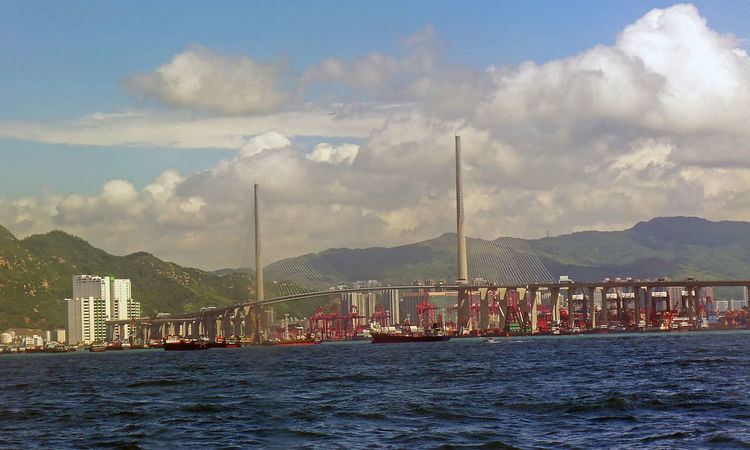Carries Route 8 Construction started 27 April 2004 Clearance below 74 m Total length 1,596 m | Longest span 1,018 m (3,340 ft) Opened 20 December 2009 Height 298 m Bridge type Cable-stayed bridge | |
 | ||
Designer Dissing+Weitling, design competition winner Similar Ting Kau Bridge, Tsing Ma Bridge, Stonecutters Island, Kap Shui Mun Bridge, Sutong Yangtze River Brid | ||
Stonecutters Bridge is a high level cable-stayed bridge which spans the Rambler Channel in Hong Kong, connecting Nam Wan Kok, Tsing Yi island and Stonecutters Island. The bridge deck was completed on 7 April 2009, making this the second longest cable-stayed span in the world at the time of its completion, and opened to traffic on 20 December 2009.
Contents
The approaches at Tsing Yi and Stonecutters Island are located near Container Terminal 9 and Container Terminal 8, respectively. Construction commenced on 27 April 2004 by Maeda-Hitachi-Yokogawa-Hsin Chong JV (a joint venture of Maeda Corporation, Hitachi Zosen Corporation, Yokogawa Bridge Corporation, and Hsin Chong). It cost HK$2.76 billion. It was reported to be over budget.
The bridge is part of Hong Kong's Route 8, connecting Sha Tin, Cheung Sha Wan, Tsing Yi island, Ma Wan and Lantau Island. Other major constructions along the route are Nam Wan Tunnel (completed in 2008), Eagle's Nest Tunnel (completed in 2008), Sha Tin Heights Tunnel (completed in 2008), Tsing Ma Bridge (completed in 1997) and Kap Shui Mun Bridge (completed in 1997).
As a result of the interesting challenges and extreme difficulty in constructing this bridge, the project was featured on two of the Discovery Channel's Extreme Engineering series on 1 November 2006 and 27 April 2009.
The Stonecutters Bridge won the 2010 Supreme Award at the annual Structural Awards presented by the Institution of Structural Engineers, United Kingdom.
Stonecutters bridge
Structure
The bridge spans 1.6 km (0.99 mi), with 3 lanes in each direction. It is a cable-stayed bridge with two bridge towers, one on Tsing Yi Island and the other on Stonecutters Island.
With a main span of 1,018 m (3,340 ft), Stonecutters Bridge has the third-longest cable-stayed span in the world, after the Sutong Bridge and Bridge to Russky Island.
It was built at a cost of HK$2.76 billion (US$356 million).
Bridge design
The design concept for the bridge was procured by Highways Department in Hong Kong through an international design competition. The winning scheme was the one presented by a group consisting of bridge architect Dissing+Weitling together with engineering firms Halcrow Group, Flint & Neill Partnership and Shanghai Municipal Engineering Design Institute. The design was selected as the Reference Scheme for the further design development. A group led by Arup with COWI A/S as main sub-consultant has carried out the further design development of the Reference Scheme and the detailed design that followed.
The concept was for a cable-stayed bridge with a twin aerodynamic deck suspended from two 295m-high single pole towers. These towers have bases measuring 24m x 18m tapering to 7m diameter at the top, and the deck allows a navigation clearance of 73.5m over the full entrance to the Container Port.
The two towers are in concrete until level +175m and in composite construction consisting of an inner concrete ring with a stainless steel skin for the top 120m. The original concept had a conventional steel structure above level +175m but Arup found that this configuration would be too lively and lead to unacceptable vibrations of the stay cables. Using a heavier composite section instead of a pure steel structure solved this problem. For reasons of durability and to enhance the appearance, further studies concluded that the tower skin should be fabricated from a duplex stainless steel (grade 1.4462 to BSEN10088) with a shot peened surface finish. The deck itself is made of steel in the main span and of concrete in the side spans.
The tower foundations are located within 10m of the seawall on either side of the Rambler Channel, close to the back-up land next to CT8 and CT9. Their proximity to the channel necessitated ship impact testing and modelling. Geotechnical centrifuge testing was conducted using a 1:200 scale model of a vessel bow section and seawall within a container.
Wind studies
The Hong Kong region is susceptible to very strong typhoon winds, a fact that was taken into account in the design of the bridge. In October 2002 a 50 m (160 ft) mast was erected at the site to measure the speed, direction and turbulence of winds in the area. Readings, which continued until January 2004, were transmitted in real-time to an offsite location for further analysis. In particular, the stability of the 509 m (1,670 ft) long cantilevers during construction required special consideration in the design.
Walk for millions
Prior to its formal commissioning, a Community Chest Walk for Millions was held 15 November 2009 to allow the public to walk along Stonecutters Bridge and East Tsing Yi Viaduct and through Nam Wan Tunnel. Over 30,000 participants took part, raising more than HK$10 million for the charity's Children and Youth Services.
